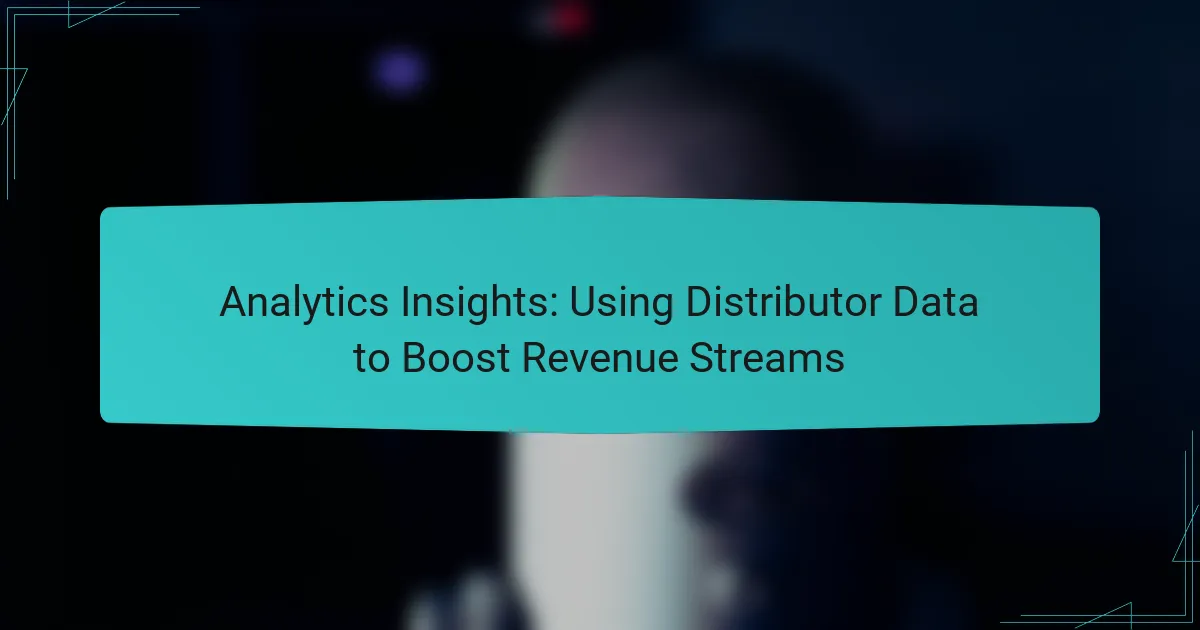Leveraging distributor data is a powerful strategy for enhancing revenue streams by offering critical insights into product performance, customer behavior, and market trends. By utilizing effective analytical tools, businesses can transform this data into actionable strategies that drive sales and improve profitability.

How can distributor data enhance revenue streams in the US?
Distributor data can significantly enhance revenue streams in the US by providing insights into product performance, customer behavior, and market trends. By analyzing this data, businesses can make informed decisions that drive sales and improve profitability.
Identifying high-performing products
Using distributor data allows businesses to pinpoint which products are generating the most revenue. By analyzing sales figures, inventory turnover, and customer feedback, companies can identify top sellers and focus their marketing efforts accordingly.
For example, if a specific product consistently outperforms others in a certain region, businesses can increase stock levels and promotional activities in that area to maximize sales potential.
Optimizing pricing strategies
Distributor data provides insights into competitive pricing and customer willingness to pay. By analyzing sales trends and competitor pricing, businesses can adjust their pricing strategies to optimize revenue.
Implementing dynamic pricing based on real-time data can help capture more sales during peak demand periods while remaining competitive in the market. Regularly reviewing pricing strategies based on distributor insights is essential for maintaining profitability.
Targeting customer segments
Understanding customer segments is crucial for maximizing revenue. Distributor data can reveal purchasing patterns and preferences among different demographics, allowing businesses to tailor their marketing efforts.
For instance, if data shows that younger customers prefer certain products, targeted promotions or advertisements can be developed to appeal specifically to that group, increasing overall sales.
Improving inventory management
Effective inventory management is vital for maintaining cash flow and meeting customer demand. Distributor data helps businesses track inventory levels and predict future needs based on sales trends.
By using this data, companies can reduce excess inventory and avoid stockouts, ensuring that they have the right products available at the right time. Implementing just-in-time inventory practices can further enhance efficiency and reduce costs.
Leveraging sales forecasting
Sales forecasting based on distributor data allows businesses to anticipate future demand and adjust their strategies accordingly. By analyzing historical sales data and market trends, companies can create more accurate forecasts.
This proactive approach enables businesses to plan for seasonal fluctuations and allocate resources effectively, ultimately boosting revenue streams. Regularly updating forecasts with new data ensures that businesses remain agile and responsive to market changes.

What tools are effective for analyzing distributor data?
Effective tools for analyzing distributor data include data visualization software, web traffic analytics, business intelligence platforms, and customer relationship management systems. These tools help businesses extract actionable insights from distributor data, ultimately boosting revenue streams.
Tableau for data visualization
Tableau is a powerful data visualization tool that allows users to create interactive and shareable dashboards. It enables businesses to visualize distributor data through graphs and charts, making trends and patterns easier to identify. This clarity can lead to more informed decision-making.
When using Tableau, consider connecting it directly to your distributor databases for real-time updates. This ensures that the visualizations reflect the most current data, allowing for timely adjustments in strategy.
Google Analytics for web traffic
Google Analytics is essential for tracking web traffic and understanding user behavior on your online platforms. By analyzing distributor data alongside web metrics, businesses can gauge the effectiveness of their marketing efforts and optimize their online presence.
To maximize Google Analytics, set up conversion tracking to see how distributor data correlates with sales. Regularly review traffic sources and user engagement metrics to refine your marketing strategies and improve revenue outcomes.
Power BI for business intelligence
Power BI is a business intelligence tool that integrates data from various sources, including distributor data, to provide comprehensive insights. It allows users to create reports and dashboards that highlight key performance indicators and trends.
Utilizing Power BI effectively involves ensuring data accuracy and consistency across all sources. Regularly update your datasets and leverage its predictive analytics features to forecast future sales based on historical distributor performance.
Salesforce for customer relationship management
Salesforce is a leading customer relationship management (CRM) platform that helps businesses manage distributor relationships and sales processes. By analyzing distributor interactions and sales data, companies can enhance customer engagement and drive revenue growth.
To get the most from Salesforce, customize your dashboards to track distributor performance metrics. Implement automation for follow-ups and lead nurturing to ensure that no opportunities are missed, ultimately increasing sales efficiency.

What metrics should be tracked for revenue growth?
To effectively boost revenue streams, businesses should track key metrics that directly influence sales performance. Focusing on sales conversion rates, average order value, customer acquisition cost, and return on investment can provide valuable insights into revenue growth opportunities.
Sales conversion rates
Sales conversion rates measure the percentage of potential customers who make a purchase. This metric is crucial as it indicates the effectiveness of your sales strategies and marketing efforts. A typical conversion rate for e-commerce businesses ranges from 1% to 3%, but this can vary widely based on the industry.
To improve conversion rates, analyze customer behavior and identify bottlenecks in the purchasing process. A/B testing different landing pages or promotional offers can help determine what resonates best with your audience.
Average order value
Average order value (AOV) represents the average amount spent by customers per transaction. Increasing AOV can significantly enhance overall revenue without needing to acquire more customers. AOV can be boosted through strategies like upselling, cross-selling, or offering bundled products.
For many retailers, a healthy AOV might range from $50 to $150, depending on the product category. Regularly reviewing this metric can help identify trends and opportunities for promotions that encourage larger purchases.
Customer acquisition cost
Customer acquisition cost (CAC) is the total expense incurred to acquire a new customer, including marketing and sales costs. Understanding CAC is essential for evaluating the efficiency of your marketing strategies. A lower CAC indicates that you are acquiring customers more cost-effectively.
To optimize CAC, focus on targeted marketing campaigns and leverage data analytics to identify high-performing channels. Aim to keep your CAC below the average lifetime value of a customer to ensure profitability.
Return on investment
Return on investment (ROI) measures the profitability of your investments in marketing and sales initiatives. Calculating ROI helps determine which strategies yield the best financial returns. A positive ROI indicates that your revenue growth efforts are effective.
To calculate ROI, use the formula: (Net Profit / Cost of Investment) x 100. Aiming for an ROI of at least 20% is a common benchmark in many industries. Regularly assess the ROI of different campaigns to allocate resources to the most effective strategies.

How do market trends impact distributor data analysis?
Market trends significantly influence distributor data analysis by shaping consumer preferences and altering demand patterns. Understanding these trends allows distributors to adjust their strategies, optimize inventory, and enhance revenue streams.
Shifts in consumer behavior
Shifts in consumer behavior can drastically affect how distributors analyze their data. For instance, an increase in online shopping may lead to higher demand for certain products, prompting distributors to focus on e-commerce metrics. Monitoring these changes helps in forecasting sales and adjusting stock levels accordingly.
Distributors should regularly survey customers and analyze purchasing patterns to identify emerging preferences. This proactive approach can reveal opportunities for new product lines or promotional strategies that align with current consumer trends.
Emerging technologies
Emerging technologies play a crucial role in enhancing distributor data analysis capabilities. Tools like artificial intelligence and machine learning can process vast amounts of data, identifying trends and insights that may not be immediately apparent. These technologies enable distributors to make data-driven decisions quickly and efficiently.
Investing in analytics software that integrates with existing systems can streamline data collection and reporting. Distributors should consider platforms that offer real-time analytics to stay ahead of market changes and consumer demands.
Competitive landscape changes
Changes in the competitive landscape can significantly impact distributor data analysis. New entrants or shifts in competitor strategies may require distributors to reassess their market position and adjust their pricing or marketing tactics. Regularly benchmarking against competitors can provide valuable insights into market dynamics.
Distributors should keep an eye on competitor promotions, product offerings, and market share. This information can inform strategic decisions, such as when to introduce new products or how to adjust pricing to remain competitive in a changing market environment.

What are the best practices for leveraging distributor data?
To effectively leverage distributor data, businesses should focus on regular audits, integration of multiple data sources, and training staff on data interpretation. These practices enhance data accuracy, provide comprehensive insights, and empower teams to make informed decisions that can boost revenue streams.
Regular data audits
Conducting regular data audits is essential for ensuring the accuracy and reliability of distributor data. This process involves systematically reviewing data for inconsistencies, errors, or outdated information. Aim to perform audits quarterly or biannually to maintain data integrity.
During audits, check for common issues such as duplicate entries, missing fields, or incorrect formats. Establish a checklist to streamline the audit process and ensure all critical data points are evaluated. This proactive approach helps in identifying and rectifying problems before they impact decision-making.
Integrating multiple data sources
Integrating multiple data sources allows businesses to gain a holistic view of their distributor performance. By combining data from sales, inventory, and customer feedback, companies can identify trends and patterns that may not be visible when analyzing a single source. Consider using data integration tools that can automate this process.
When integrating data, ensure compatibility between systems and standardize formats to facilitate analysis. This may involve using APIs or data warehouses. A well-integrated data ecosystem can significantly enhance forecasting accuracy and operational efficiency.
Training staff on data interpretation
Training staff on data interpretation is crucial for maximizing the value of distributor data. Employees should understand how to analyze and draw insights from data, which can lead to better decision-making. Offer workshops or online courses focused on data analytics and visualization tools.
Encourage a data-driven culture by providing resources and support for ongoing learning. Regularly share success stories where data interpretation led to improved outcomes. This not only enhances skills but also fosters a sense of ownership and accountability among team members.



